Most lifters obsess over the long head of their triceps (horseshoe everyone wants), while completely ignoring the medial head.
Big mistake.
After 10+ years of training and studying biomechanics, I’ve discovered that the medial head is the unsung hero of impressive tricep development.
When properly developed, this inner portion of your triceps creates that dense and bigger look.
In this guide, I’ll break down:
- The exact biomechanics of medial head activation
- 7 scientifically proven exercises
- Pro tips and form
- A complete programming strategy to build bigger, stronger arms
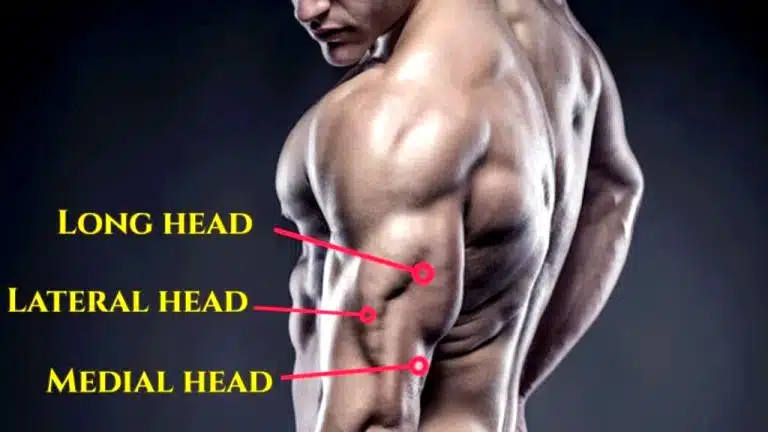
- How To Train The Medial Head Tricep
- 10 Best Medial Head Tricep Exercises
- 1. Reverse-Grip Tricep Pushdown
- 2. Skull Crusher
- 3. Dumbbell Kickback
- 4. Close-Grip Bench Press
- 5. Reverse Grip Bench Press
- 6. Dumbbell Tate Press
- 7. Barbell JM Press
- 8. Overhead Dumbbell Triceps Extension
- 9. Rope Triceps Extension
- 10. Diamond Push-Ups
- Beginner Medial Head Tricep Workout Plan
- Dumbbell Only Medial Head Tricep Workout
- Takeaways
- References
How To Train The Medial Head Tricep
It is impossible to fully isolate any one of the tricep muscle heads during an exercise. But it’s possible to focus on one or more of these muscle heads at the expense of the others.
The tricep muscle, also known as the triceps brachii, comprises of three heads:
Lateral Head: On the outer side of your upper arm. It originates from the upper portion of the humerus bone and is responsible for shoulder extension.
Long Head: Runs down the back of your upper arm, the largest of the three. The long head originates from the infraglenoid tubercle of the scapula (your shoulder blade).
Medial Head: Deeper, beneath the lateral and long heads, closer to the bone. It has two origins:
- The posterior surface of the humerus and distal to the radial groove.
- Like the other triceps heads, the medial head inserts into the olecranon process of the ulna via a common tendon.
All three heads aid in elbow extension, but the medial head is the primary extensor because it is used in all elbow extension motions regardless of arm position.
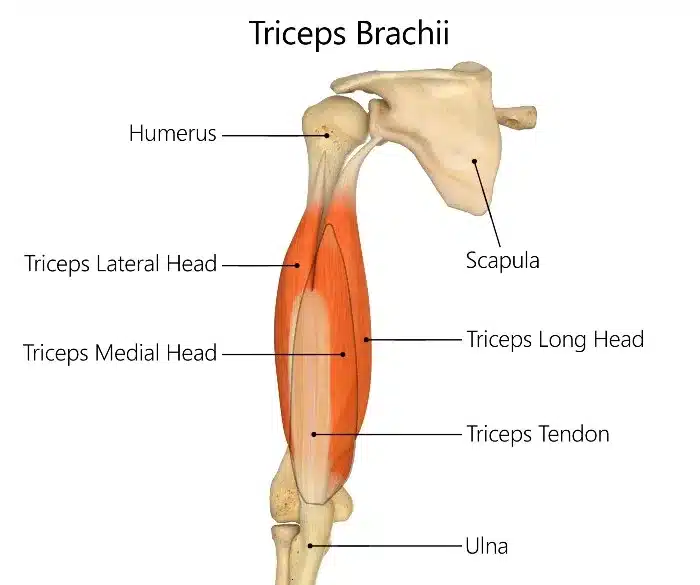
To effectively target the medial head based on its anatomy and biomechanics:
- When you do exercises using a reverse (underhand) grip, such as reverse-grip pushdowns, the medial head activation is enhanced due to the altered line of pull and reduced involvement of the long and lateral heads.
- Keep elbows tucked close to the body. This reduces lateral head involvement and shifts focus to the medial and long heads.
- Since the medial head is a stabilizer and endurance muscle, it’s most active when you do full extension at the elbow, especially the final phase (“lockout”). So focus on high reps, low to moderate weight, and strict form.
- Studies have observed that the medial head of the triceps generates its highest force during elbow flexion between 85° and 110°. When performing skull crushers (lying triceps extensions), your elbows move through this flexion range, which allows for significant medial head activation.
10 Best Medial Head Tricep Exercises
Now, let’s get into the best tricep medial head strength and hypertrophy exercises using various types of fitness equipment, such as a barbell, dumbbells, cable machine, and some bodyweight tricep exercises.
1. Reverse-Grip Tricep Pushdown
The standard pushdown primarily targets the lateral head of your triceps. But flip your grip to supinated (palms facing up) to train the medial head of the triceps.
In this exercise, the reverse (supinated) grip externally rotates the shoulders and places the elbows closer to the body. This:
- Encourages strict elbow positioning and better isolation.
- Minimizes lateral head involvement.
- Increases medial head recruitment.
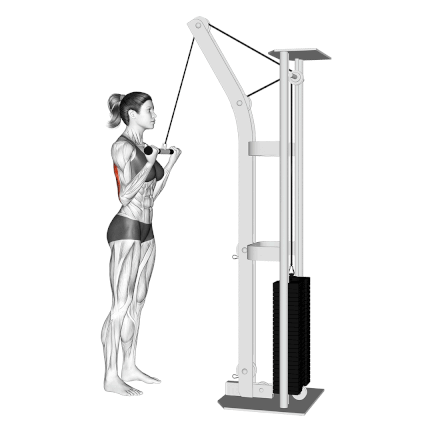
How To Do It
- Stand facing a high-pulley cable with a short straight bar attached to it.
- Slightly bend your knees, and your feet should be about shoulder-width apart.
- Grasp the bar with a supinated (palm up) grip, hands shoulder-width apart.
- Hold the bar at chest level with your elbows tight against your sides.
- Keep your elbows still and straighten your arms until they are fully extended.
- Pause at full arm extension, flex your triceps, and slowly return the bar to the starting position.
Tips
- The reverse grip can put more stress on the wrists. If you have wrist issues, be cautious and use a lighter weight. You can also try using an EZ-curl bar attachment to reduce wrist strain.
- Keep your elbows close to your body throughout the exercise to maximize triceps isolation. Avoid letting your elbows flare out.
2. Skull Crusher
The skullcrusher, also known as a lying triceps extension, is a highly effective compound exercise for building triceps strength and size. It allows for a good stretch and a strong contraction.
The name “skull crusher” comes from the exercise’s mechanics of bringing the weight down to your skull from an overhead position.
When done correctly, they are among the few exercises that permit deep elbow flexion while maintaining tension on all three triceps heads, particularly the medial head.
There are many other variations of skull crusher that you can do to maximize the muscle stimulation.
- Dumbbell Skull Crusher
- Cable Skull Crusher
- Ez Bar Skull Crusher
- Incline Skull Crusher
- Decline Skull Crusher
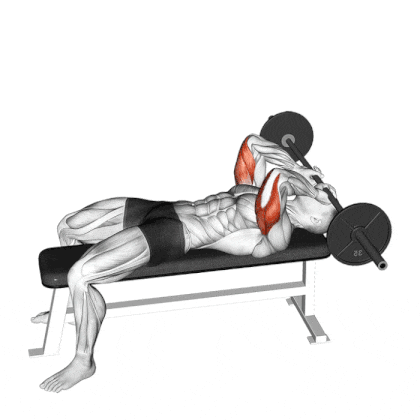
How To Do It
- Lie down on a flat bench with your feet firmly planted on the ground.
- Grip the bar (EZ bar, straight bar, or dumbbells) with hands shoulder-width apart.
- Extend your arms straight above your chest, perpendicular to the floor.
- Keep your elbows still and tucked, not flared, and only bend them at the elbows to bring the weight down to your forehead or just behind your head.
- Control the movement and try to get the weight just above your forehead without touching it.
- Pause briefly at the bottom position, feeling the stretch in your triceps.
- Then, lift the weight back up by extending your elbows until your arms are fully extended.
- Perform 3–4 sets of 8–12 repetitions.
Tips
- Do not let elbows flare—keep them tucked for maximum medial head activation.
- Start with a lighter weight and gradually increase it as you get stronger.
3. Dumbbell Kickback
Kickback engages all three; the specific position (bent-over, arm held back) emphasises the long head more, especially at the movement’s top. The lateral and medial heads are still working.
It is an isolation exercise, which means that, unlike other exercises such as the push-up or bench press, the tricep kickback targets explicitly the triceps muscle.
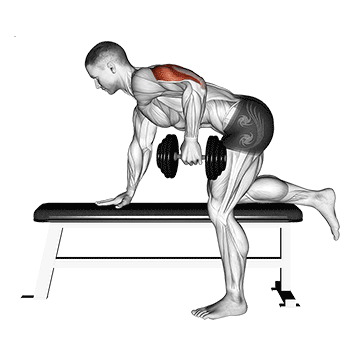
How To Do It
- Place your right knee and palm on a flat bench so that your torso is parallel to the floor.
- Hold a dumbbell in your left hand. Put your left foot flat on the floor and press your left arm tight against your side. Your upper arms should be straight out from your body.
- Bring the dumbbell up until your upper arm is parallel to the floor. Your upper arm should be relatively fixed here, only the lower arm move.
- Flex the triceps hard for a second, then return to the starting position.
- Complete all reps on the left arm and then repeat on the right arm.
Tips
- Use a weight that allows you to fully straighten your arm and hold a squeeze for a second. Don’t just go through the motion; focus on the muscle contraction at the top.
- Keep your body as still as possible; move only your forearms.
4. Close-Grip Bench Press
The close grip bench press is a variation of the bench press and an exercise used to build muscle and strength in the triceps.
It is a compound exercise that simultaneously works for multiple muscle groups. In addition to the triceps, it also works the chest, anterior deltoids, and serratus anterior.
A study has also shown that compared to the traditional bench press, this narrower grip shifts the emphasis more towards the triceps brachii and less on the pectoralis major and shoulder.

How To Do It
- Lie flat on your back on the bench. Plant your feet firmly on the floor.
- Reach up and grasp the barbell with a pronated (overhand) grip. Your hands should be closer together than your standard bench press grip.
- Grip the bar width that is approximately shoulder-width apart, or slightly narrower – no more than one hand width inside shoulder width on each side. Avoid gripping too narrowly, as this can place excessive stress on your wrists and elbows.
- Before unracking, retract your shoulder blades by squeezing them together and slightly depressing them (pulling them down towards your hips).
- Take a deep breath, brace your core, and unrack the bar from the supports with your elbows locked. Slowly move the bar forward so it is positioned directly over your chest.
- Lower the bar slowly and under control. Actively tuck your elbows towards your sides. They should track downwards at an angle of roughly 45 degrees relative to your torso.
- Exhale forcefully as you press the bar back up towards the starting position.
- Once you’ve completed your set, carefully return the bar to the rack.
Tips
- Keep your elbows at about a 45-degree angle relative to your torso. Avoid flaring the elbows out excessively or tucking them too close to your body.
- Do a full range of motion. Lower the barbell until it is close to your chest. Press it back up to full arm extension without locking out the elbows.
5. Reverse Grip Bench Press
The Reverse Grip Bench Press is a variation in which you grip the bar with your palms facing up (supinated grip) instead of the traditional palms-down (pronated) grip.
The reverse grip externally rotates the shoulder, naturally forcing the elbows to tuck closer to the torso. This changes the triceps’ loading mechanics:
- The medial head takes on more of the load due to the narrower elbow path and consistent elbow extension.
- It limits shoulder dominance, reducing anterior deltoid involvement.
- Greater elbow flexion-extension angle maintains medial head tension across the full ROM.
- Additionally, it lowers stress on the shoulders, making it a better option for people with shoulder pain when doing regular pressing movements.
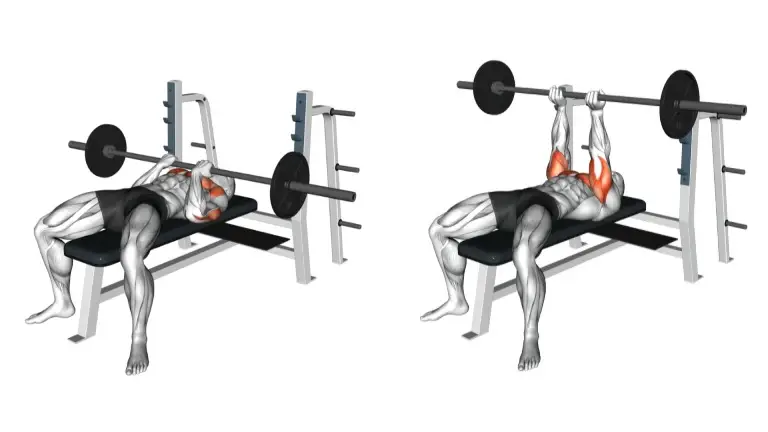
How To Do It
- Lie supine (on your back) on a flat bench. Plant your feet firmly on the floor for stability.
- Grip the bar with an underhand (supinated) grip, slightly wider than shoulder-width. Be sure to grip the bar tightly.
- Unrack the bar carefully. Keep elbows tucked close to your torso.
- Lower the bar slowly and with control towards your upper chest/clavicular region.
- Drive the bar upward, emphasising elbow extension rather than “pushing.” Visualize your triceps contracting to move the weight.
Tips
- The reverse grip can feel awkward at first. To master the movement pattern, begin with an empty bar or very light weights.
- Due to the unusual grip, always use a spotter for safety, especially as you increase the load
6. Dumbbell Tate Press
The dumbbell Tate press is a variation of the tricep extension and an exercise used to build stronger triceps. It is an advanced tricep exercise that moves the muscle differently but still targets and builds the tricep muscle.
For bodybuilders, the Tate press will offer a unique range of motion to target the triceps. This will help in building a complete pair of horseshoe triceps.

How To Do It
- Lie down on a flat bench, and your feet are firmly planted on the floor at the other end.
- Hold a dumbbell in each hand, facing your palms towards your feet.
- Engage your abs, keep your back on the bench, and raise the weights to the center of your chest.
- Slowly raise your arms up and down without moving your elbows by contracting your triceps.
- Repeat for as many reps and sets as desired.
Tips
- The exercise’s slow eccentric (lowering portion) can help improve tension and mind-muscle connection.
- Never load up to where you cannot maintain a stable body position. This is an isolation exercise that does not require maximum loads.
- Keep your arms close to your head for maximum triceps engagement.
7. Barbell JM Press
The JM press combines a close-grip bench press and a barbell skull crusher (triceps extension). It is a compound exercise that targets the triceps and works the chest and shoulder.
This exercise uniquely targets the medial head triceps by combining elements of a skull crusher (tricep extension) and a close grip bench press.
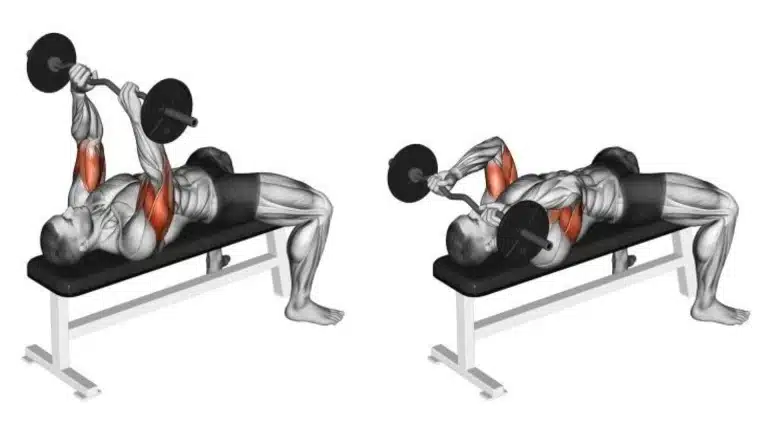
How To Do It
- Lie on a flat bench with a barbell, similar to the starting position for a bench press.
- Grasp the barbell closer than shoulder-width apart with your hands and your thumbs wrapped around the bar.
- Lower the bar towards your chin or upper chest by simultaneously bending your elbows.
- Unlike a standard bench press, the elbows should move both downwards and backward.
- As the bar descends, it should move in a semi-circular path.
- From the lowest point, exhale as you press the barbell back up to the starting position.
Tips
- This exercise requires practice. Start light and increase weight as you master proper form.
- Keep your elbows high and approximately 45 degrees out to your sides.
- Prevent your elbows from flaring out to maintain proper form.
8. Overhead Dumbbell Triceps Extension
The dumbbell overhead tricep extension is a fantastic exercise that builds optimal muscle and strength in all three heads of the tricep muscle.
It’s highly effective, relatively simple to learn, and requires minimal equipment – just a dumbbell and maybe a bench.
However, the long head originates on the scapula (shoulder blade) and crosses the shoulder joint. When your arm is raised overhead, the long head is stretched and contracts forcefully during the extension.
Recent findings also suggest that doing these extensions in an overhead position leads to more pronounced tricep muscle growth.
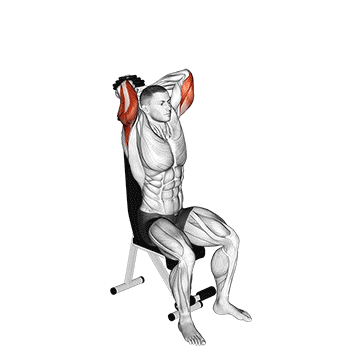
How To Do It
- Sit upright on a bench (with or without back support – back support can help maintain core stability).
- Grasp the dumbbell with both hands, cupping the weight head with your palms and thumbs around the handle (or hands flat against the underside of the top weight plate).
- Slowly lower the dumbbell behind your head, bending only at the elbows. Lower as far as you can comfortably without losing form.
- Keep your elbows tucked in close to your head or ears throughout the movement. They should point mostly forward or slightly outward, not flare out wide to the sides.
- Extend your arms back up while squeezing your triceps hard to get back to the starting position.
Tips
- Keep the head fairly neutral; don’t let the neck jut forward.
- The only joint that should be significantly moving is your elbow. Minimise swinging or movement at the shoulder.
- The chin should remain parallel to the floor, and the core should be braced.
9. Rope Triceps Extension
The rope tricep extension is another great exercise for your tricep workout for the medial head.
It is a variation of the cable tricep extension exercise, which builds the triceps’ muscles.
Well-built triceps also have numerous positive effects on pressing movements, such as bench press and shoulder press variations.

How To Do It
- Keep feet shoulder-width apart, and face a high pulley machine enabled with a rope attachment.
- Grasp the ends of the rope so that your palms face inward and your elbows are by your waist.
- Keep your body still and breathe out slowly as you lower the rope by extending your arms straight down by your sides.
- Hold for a moment and then inhale as you slowly return the rope to the starting position.
Tip
- Use only your forearms as you raise and lower the rope.
- Standing upright with the spine straight is the standard position.
- Contract your triceps as you lower the rope.
10. Diamond Push-Ups
If you’re looking for a good bodyweight exercise to train and work your medial tricep, then diamond push-ups are it.
Diamond or triangle push-ups are a more advanced variation of the classic push-ups.
During it, your hands and forefingers are brought together almost directly under the chest to make a diamond or triangular configuration.

How To Do Diamond Push-Ups
- Get on the floor with your hands together under your chest.
- Position your index fingers and thumbs so they’re touching, creating a diamond shape.
- Now, extend your arms to elevate your body and form a straight line from your head to your feet.
- Lower your chest towards your hands, ensuring you don’t flare your elbows to the sides, and keep your back flat.
- Stop just before your chest touches the floor, then push back up to the starting position.
Tips
- Keep your body straight and rigid.
- To make the diamond push-up easier, do it on your knees.
Related Post: 15 Bodyweight Triceps Exercises: Beginner To Advanced
Beginner Medial Head Tricep Workout Plan
| Exercise | Sets | Reps |
|---|---|---|
| Bench Dip | 4 | 10-15 |
| Reverse-Grip Triceps Pushdown | 3 | 10-15 |
| Rope Triceps Extension | 3 | 10-15 |
Dumbbell Only Medial Head Tricep Workout
| Exercise | Sets | Reps |
|---|---|---|
| Diamond Push-Ups | 4 | 8-12 |
| Dumbbell Triceps Extension | 3 | 10-15 |
| Close-Grip Dumbbell Press | 3 | 8-12 |
| Dumbbell Kick Back | 3 | 10-15 |
Takeaways
Training the medial head tricep is important for building a bigger and stronger tricep.
Now, we have many exercises to train the medial head of the tricep, such as the close-grip bench press, dips, cable reverse grip pushdowns, and lying triceps extension.
It’s important to choose exercises that work well with your workout routine and your body’s needs.
Remember to aim for at least one triceps workout a week for optimal results.
Please let me know in the comments if you have any questions I can help you with.
References
- American Council on Exercise: ACE Study Identifies Best Triceps Exercises (source)
- Kholinne E, Zulkarnain RF, Sun YC, Lim S, Chun JM, Jeon IH. The different role of each head of the triceps brachii muscle in elbow extension. Acta Orthop Traumatol Turc. 2018 May;52(3):201-205. doi: 10.1016/j.aott.2018.02.005. Epub 2018 Mar 2. PMID: 29503079; PMCID: PMC6136322.

Manish is a NASM-certified fitness and nutrition coach with over 10 years of experience in weight lifting and fat loss fitness coaching. He specializes in gym-based training and has a lot of knowledge about exercise, lifting technique, biomechanics, and more.
Through “Fit Life Regime,” he generously shares the insights he’s gained over a decade in the field. His goal is to equip others with the knowledge to start their own fitness journey.
